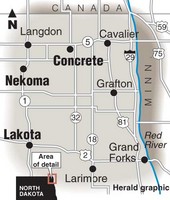Chuck Haga, Grand Forks Herald (May 15, 2010)
Forty years ago today, anti-war protesters from UND and throughout the region assembled near Nekoma, N.D., site of a planned anti-ballistic missile defense system, to demonstrate against the arms race and the war in Vietnam.
Two of the "Chicago Seven," John Froines and Dave Dellinger -- defendants in one of the most celebrated anti-war conspiracy trials of the period -- spoke on campus the night before and joined the students and other protesters May 15, 1970, at Nekoma.
It was one of the largest area protests of the Vietnam era, and it came just a week and a half after four students at Kent State University were shot and killed by soldiers of the Ohio National Guard, called to campus to quell anti-war demonstrations there.
At Nekoma, a village of 87 people, students danced, sang and listened to rock bands on a makeshift stage, and they planted ash trees and durum seed "to show people," organizers said, "what this land was meant to hold."
The Safeguard complex in Nekoma was part of a planned national missile defense system. The only Safeguard unit ever to become operational, it was shut down less than a year later.
The complex consisted of a missile site radar, four remote Sprint missile launch sites, and a perimeter acquisition radar, to the north at Concrete, N.D.
Its development coincided with widespread anger over the U.S. incursion into Cambodia and the disaster at Kent State. Peace activists called for an "International ABM Day" across the country, and the march on Nekoma was organized by North Dakota Clergy and Laymen Concerned and North Dakota Citizens for a Sane Nuclear Policy.
Estimates of the crowd ranged from 500 to 1,500, and the event came to be called the Nekoma Festival of Life and Love, according to the rather disapproving Internet site globalsecurity.org.
"Because Gov. William Guy would not allocate resources to protect federal property, the Army and the four-company consortium, Morrison-Knudsen and Associates, established a non-provoking strategy consisting of removing all mobile equipment, roping off the excavation and setting up a stage and sanitary accommodations for the protesters away from the construction," according to the site.
"Late in the afternoon, several hundred demonstrators marched toward the excavation as kazoo players played 'The Battle Hymn of the Republic.' Upon arrival, the protesters descended into the hole and performed some symbolic activities such as planting seedlings.
"Overall, the Army's passive strategy worked, as the day went without violence or arrests and only minimal vandalism."
'In best tradition'
Clay Jenkinson, a historian and writer who teaches at Dickinson State University and Bismarck State College, offers a different take on the protest -- and on the role played by Guy, governor from 1961 to 1973, now 90 and living in Fargo.
On May 12, 1970, "a nervous and hostile U.S. Justice Department sent out a riot control team to meet with Guy," Jenkinson wrote in a recent column published in the Bismarck Tribune. "In his calm and competent way," the governor assured his visitors that appropriate steps would be taken.
Then, Guy addressed the people of North Dakota.
"I do not expect violence in this week's demonstrations," he said days before Nekoma, "especially by those who point to the destructive waste of violence and war." Also, "Peaceful demonstrations are in the best tradition of this country's democratic process."
Guy said he would put the North Dakota National Guard on "strategic weekend drill status," but the soldiers would stay out of sight and not carry ammunition.
On May 13, Guy flew to Grand Forks and met with faculty members and students. "The atmosphere was tense and explosive," he wrote in a 1992 memoir.
While he was talking to the students, someone handed him a note. U.S. Attorney General John Mitchell was calling.
"Mitchell pressured the North Dakota governor to use the North Dakota National Guard to secure the ABM site," Jenkinson wrote. "Guy flatly refused. It was a federal not a state facility. Besides, he said, American citizens had a perfect right to engage in peaceful demonstrations."
Mitchell asked Guy if he would be at Nekoma.
"Only if they need one more warm body to swell the crowd," Guy responded. "You see, I too protest the waste of tax money that the ABM represents."
According to Guy's recounting of the conversation, the attorney general swore and hung up on the governor.
Two days later, protesters occupied the site, where they flew kites, danced, planted their symbolic trees and seeds and denounced the war and arms race in song, poetry and speeches. State troopers and area sheriff's deputies assisted student marshals with traffic control, while the National Guard hunkered down in Lakota, N.D., 40 miles away.
"Nekoma," Jenkinson wrote, "had more in common with Woodstock than Kent State."
ABM treaty
When President Richard Nixon and Soviet leader Leonid Brezhnev signed the ABM Treaty on May 26, 1972, agreeing to limit each nation to one site to protect strategic forces and one site to protect the national command authority, work was about 85 percent complete at Nekoma. The United States stopped work at a site in Montana.
In spring 1975, the North Dakota ABM site received its complement of nuclear-tipped Spartan and Sprint missiles, and the site was declared operational on April 1, 1975, according to globalsecurity.org. "Due to Congressional action, the Army operated the site for less than a year (and) the complex was abandoned in February 1976."
Reach Haga at (701) 780-1102; (800) 477-6572, ext. 102; or send e-mail to chaga@gfherald.com.

